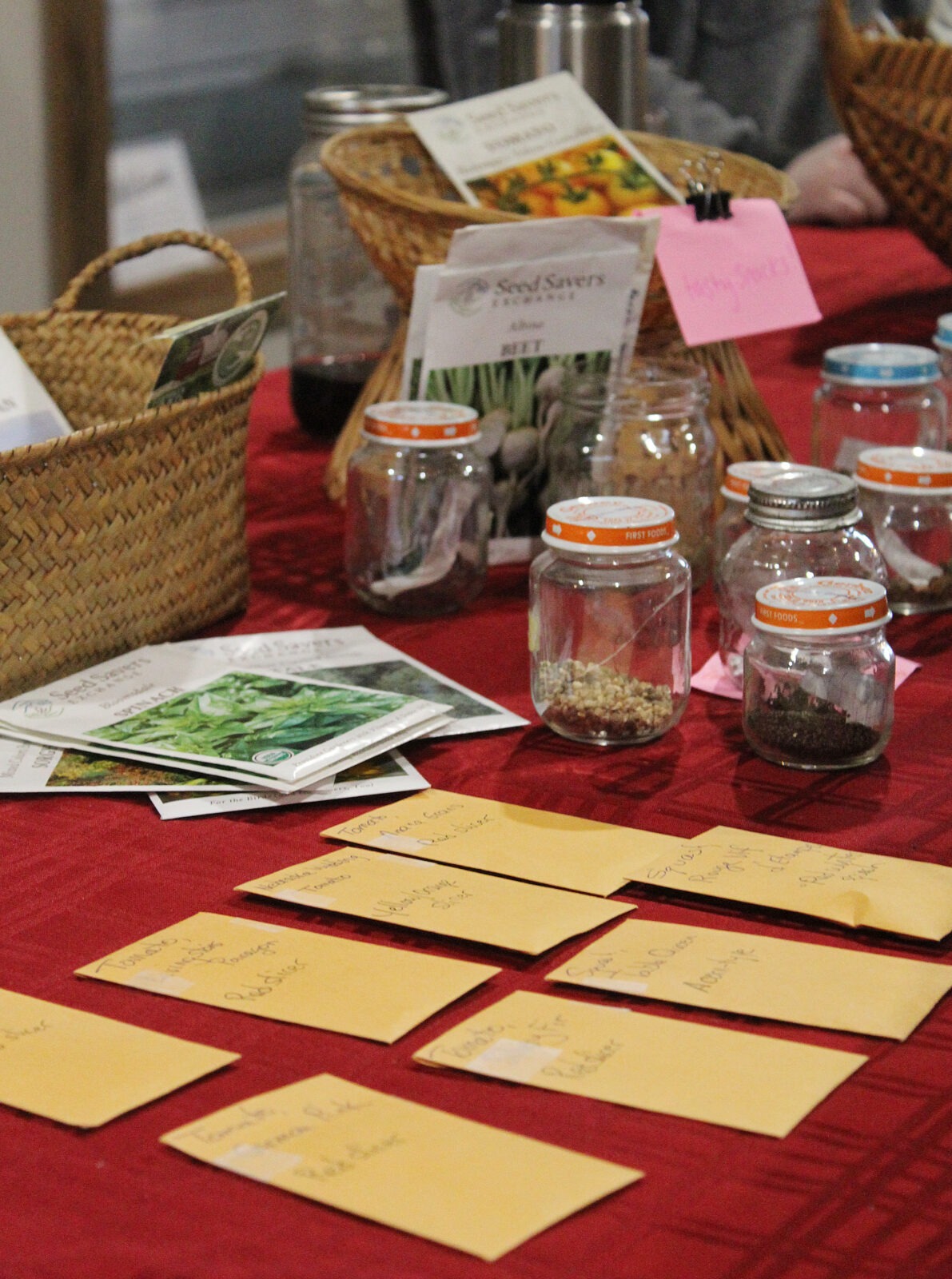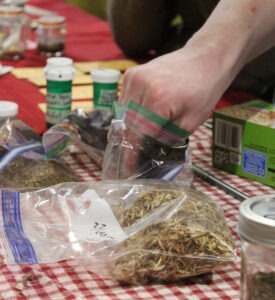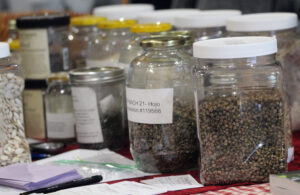How to Organize a Seed Swap

How to Organize a Seed Swap
A seed swap is a gathering of people, usually gardeners and farmers, who have come together to share seeds. Open seed sharing is one of Seed Savers Exchange’s core values since our founding 50 years ago. Keep reading to learn how to organize a seed swap of your own!
Seed swaps are nothing new! Humanity has been organizing seed swaps for 10,000 years, coming together at markets, town squares, in huts and in halls to swap seeds and stories.
But seed swaps are being rediscovered by a new generation of plant people, and their collective joy, excitement, and knowledge is really at the core of the community seed movement.

National Seed Swap Day
While seed swaps are not a new concept, National Seed Swap Day was started and registered by Kathy Jentz, editor and publisher of Washington Gardener Magazine, and the first official event was held on January 26, 2006.
In 2024, Jentz presented at the Seed Savers Exchange virtual conference, “Growing Together: Sharing Seeds, Skills, and Stories,” and shared that her inspiration for founding National Seed Swap Day was to encourage communities to hold in-person seed-swapping events.
Celebrated annually on the last Saturday of January, National Seed Swap Day presents a great opportunity for gardeners to explore new plants, support biodiversity, and cultivate community. Seed swaps don’t have to be held that exact Saturday but are best hosted around that time of year as that is when gardens are often planned; they just have to be open to the public.
Celebrate National Seed Swap Day with SSE!
What is a Seed Swap?
 A seed swap is a gathering of people, usually gardeners and farmers, who have come together to share seeds. These seeds can include locally saved seeds, excess bought seeds, seeds brought back from another region or country, or excess seeds donated by a seed company.
A seed swap is a gathering of people, usually gardeners and farmers, who have come together to share seeds. These seeds can include locally saved seeds, excess bought seeds, seeds brought back from another region or country, or excess seeds donated by a seed company.
Seeds are spread on tables, and people choose what they want. Sometimes seed savers sit with their seeds to share information and monitor what is taken.
There are many ways to organize a swap, but the main goal is to bring people together to share seeds.
Who Attends a Seed Swap?
When Seed Savers Exchange hosts a seed swap, anyone who’s interested in seeds or gardening can attend! This includes:
- Experienced seed savers who want to connect, expand their collections, and improve their skills.
- New gardeners and seed savers who want to learn about crop diversity, regionally adapted varieties, seed politics, and the power that comes from developing local seed solutions.
- People who have never gardened before and are curious about seeds or gardening!
Seed swaps also offer the opportunity to cultivate a network of people interested in ongoing seed projects and to collectively develop and share seed that supports a more diverse and resilient local food supply.

How to Plan a Seed Swap
Seed swaps can take place anytime, but are most popular in late January as gardeners and farmers are typically planning their next growing season.
Seed swaps can be stand-alone events or part of other happenings— farmers markets, art festivals, flower shows, conferences for gardeners, or other educational events. Collaborating with organizers of another event may make it easier to start a new seed swap.
Whether you are organizing as part of another event, starting from scratch, or planning a seed swap for just your friends, consider these questions:
What are your goals for organizing the seed swap?
- Will your event include an educational program or talk about seed saving?
- Will a plant swap, food potluck, or any type of presentation or performance be part of the event?
- Do you want attendees to stay connected after the event for future seed projects?
- Is the swap a fundraiser?
Who will attend the seed swap?
- How many people do you want to attend?
- Will the event be by invitation only or open to the public?
- Will your audience include seed savers of all levels of experience
- How much help and what type of skills do you need from fellow organizers?
When will the seed swap take place?
- Is this a one-off event or the beginning of a series of seed swaps or events?
- When is the best time for gardeners in your community to share seeds?
What kinds of seeds will be shared at the seed swap?
- Open-pollinated only?
- Local only?
- Organic only?
- Will commercial seed be allowed or only garden-saved?

At seed swap events hosted by Seed Savers Exchange, there are set guidelines for the types of seeds allowed.
Allowed
- Open-pollinated seeds.
- Locally saved seeds.
- Excess-bought seeds.
- Seeds brought back from another region or country.
- Excess seeds donated by a seed company.
Prohibited
- Seeds or plants that are considered illegal, either federally in the United States of America or the state of the event.
- Genetically engineered plants, F1 hybrids, poisonous, noxious, or controlled seeds, and plants.
- Patented varieties. Although it is legal for gardeners to grow and save patented varieties, it is illegal to distribute them. Refer to the USDA website for a list of patented varieties.
- Unknown seed from volunteer plants.
How to Organize a Seed Swap

One of your roles as an organizer is to find other enthusiastic people who can help plan the swap. For a large event open to the public, start organizing several months ahead of time. A smaller seed swap for people you know may require less planning. The following steps will help you get started:
Enlist helpers
Reach out to groups for collaboration, volunteers, donations, or other support. Interested groups may include
- Garden clubs
- Master Gardeners
- Community gardens,
- Nurseries
- Slow Food groups
- Churches
- Libraries
- Agriculture groups
- Food co-ops
You may choose to include speakers or educators to give brief presentations on gardening, seed saving, native flower seed collection, planting tips, and the importance of biodiversity. Enlist people who could speak about the history and value of seeds, techniques for planting or saving seeds, or how people can stay involved in saving seeds in their communities after the seed swap.
Secure a space
Libraries, farmers’ markets, or other community spaces are great options for holding a seed swap. Make sure the space has enough standing and table space for people and seeds.
If hosting a speaker, performer, or demonstration, choose a venue that has enough space for seating as well as a staging area and audiovisual equipment, if necessary.
Swaps can feel chaotic if squeezed into too small a space. The sooner you secure an adequate space, the sooner you’ll be able to set a date and time and start promoting the event.

Make sure there are enough seeds
Unless you’re certain that some experienced seed savers will bring excess seed, consider collecting an initial supply of seeds before the event. Seed companies and nurseries may be willing to donate seeds.
If this is the first seed swap in your community, chances are good that more people will show up to take seed than to bring seed.
To avoid running out of seed, limit the number of packs each person may fill, or allow people who bring seed to fill more packets than those who don’t (this also will encourage folks to bring seed). Or post signs asking people to take only small amounts, and encourage people who bring seed to stay with it and monitor quantities.
Your policy may be adjusted based on how many people attend and how many people bring seeds to swap.
How to Promote a Seed Swap
Promotion is very important to having a successful event. Here are some ways to promote a seed swap:
- Spread the word through local community boards/calendars and through local media, such as newspapers.
- Partner with local businesses or organizations and ask them to help spread the word.
- Promote your event on social media.

If possible, include information about seeds that are allowed and how those seeds should be labeled and packaged. Seeds should be pre-portioned in bags/envelopes, or larger jars with spoons and seed envelopes. Seeds should also be labeled carefully and clearly with as much information as possible, including crop type, common name, and variety, year the seeds were collected, where the seeds were grown, and any additional information participants wish to share.
How to Set Up a Seed Swap
Arrange tables and chairs before the event starts. Ask participants to bring seeds and arrive 15-30 minutes before the start to allow time to set up.
To start, post signs asking people to take only small amounts, or what they would typically grow in a season. Be specific—for example, to grow one plant, take 2-3 seeds. This will help ensure there is enough seed throughout the event. The policy may be adjusted based on how many people attend and how many people bring seeds to swap.

Most participants will not need their own table and can share, but may require more space if they bring a lot of seeds and want to stay with their seeds and talk about their varieties. Attendees are not required to staff their own table and may move about and enjoy the swap.
Having a sign-in sheet will help attendees stay connected after the event. Have a “take table” with seed catalogs, brochures, or other sponsor materials. Seed catalogs can provide a lot of educational information, growing tips, the history of different varieties, and more.
Finally, bring the group together at some point to share why the event was organized, why seed diversity matters, and whether there is any planned educational programming.
At the end, thank everyone for coming, and if there is leftover seed, share it with local seed libraries or other community gardens and groups.
Remember, there are a lot of different ways to plan and structure your local seed swap. For other ideas, check out the Community Seed Network.
Happy swapping!